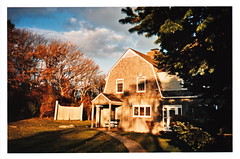 Image by Jim's Theme 1969 via Flickr
Image by Jim's Theme 1969 via Flickr
Good composition - or the effective arrangement of all of the visual elements that fall withing the frame of the final image - is critical to the success of any photograph. When the image elements are carefully placed, the viewer is engaged in the image; without an effective composition, the eye wanders through the frame and the intended subject may be diminished by distracting colors, shapes, or other pictorial elements. In this book, master photographer Ernst Wildi shows you how to fine-tune your photographs and ensure the most dynamic, powerful image possible. Easy-to-read text is paired with ample before-and-after photos, making it wasy to see how each technique will affect your final images.
FEATURES:
- Composition techniques for photographing landscapes, architecture, still life, people, and more
- Understanding the impact of technical consideration, like exposure, contrast, and depth of field, on composition
- Tips for selecting the right lens and focal length
- Using lines as compositional elements, with tips for placing lines effective and avoiding distracing lines
- Determining how to place your subject effectively in the frame of the image - including tips for composing images with multiple subjects
- Understanding the importance of color when designing effective photographic compositions
- Tips for evaluating each scene for attracting and distracting elements
- Composing effective panoramic images
- Using filters to improve your compositions
- Evaluating the background of your image, and tips for working with problematic background elements
- How posing affects the composition of a portrait
- Tips for post-capture image manipulation that let you fine-tune your compositions
What I learned from this book
Aside from the usual, these are new ideas that I got from this book:
- When shooting waterfalls, make sure that there is one, not two, waterfalls, in the frame. Two usually distracts the attention of the viewer, and the composition fails to arrest the viewer's attention.
- When shooting waterfalls, include the top and bottom. Viewers want to know when the water is coming from, and where the water is going.
- Change focal length to make the composition better. When a statue or a sculpture includes a background, such as a tree or anything of that sort, and it detracts from the overall 'correctness' of the composition, change lens. Compose the picture in such a way that the background will augment, at the least, not clutter, the resulting photograph.
- There should be balance in the colors. When composing a shot, especially on landscape photographs, make sure that the light and dark areas are properly positioned. All dark at the top or all dark at the bottom makes a photograph one-sided, and will tip off and topple.
- Use the correct focal length to signify 'size'. Change from wide angle lens to telephoto lens to signify the size of a truck against a looming mountain. Do that for all other shots that need to have the size or size relationship of the subjects in the photo emphasized.
And more!
What's your say?
Blogged with the Flock Browser
![Reblog this post [with Zemanta]](http://img.zemanta.com/reblog_e.png?x-id=8a8135c7-9edf-473f-81d0-51797c1cb0c5)
No comments:
Post a Comment